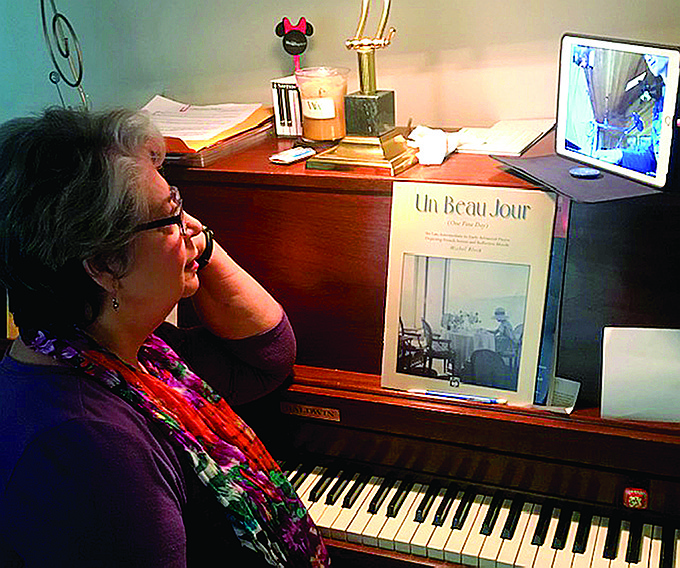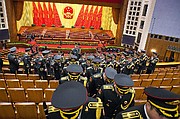TEXARKANA - With social distancing and quarantining the methods at hand to beat the coronavirus pandemic, teachers will create all sorts of ways to instruct students without being in their physical presence.
That truth extends to music teachers, who have long taught in the same space with students to watch them finger a chord, hit the drums or pound notes on the piano. It's an up-close sort of instruction.
Life finds a way, as they say, and so will raising our future music makers so they may express all the beautiful, true things music communicates.
The experience of teaching via webcam, iPad or even a smartphone is generally unique and different for these local teachers and students. Now, however, it's a necessity.
For piano teacher Vicki Carr, moving to online teaching is a less intimate form of instruction. She's not there with a student to read their body language, much easier to asses in person while sitting nearby or next to them. She's taught privately for years and worked for a Texarkana school district, where they had a piano lab.
But at least she and her students have ready-made platforms for getting together in a virtual classroom space.
"The use of FaceTime, I've been lucky all my students have iPads," Carr said. For anyone with Samsung, she'll use Skype. She parks her own iPad on top of her piano so students can see her "face to face," so to speak.
"They put their screen kind of at the end of the piano so I can see the keys and their hands, and usually some part of their face," she said.
Students already have assignments, and when they move on from these lessons she'll scan something or have assignments sent via Amazon or Sheet Music Plus.
"My teaching style doesn't change really. The difference for me is that it's just not as intimate. Because I've been teaching long enough and I really enjoy that one-on-one with somebody, I can sit at their elbow and I can actually almost read their mind," Carr said.
Before students even press a wrong note, she can often sense it. This is more easily done in person.
"The advantage of watching their eyes, and you can feel somebody's frustration. Being close to them definitely makes for a more productive lesson," Carr said. "But in a pinch, this works pretty well."
She has seven students, one of whom is a voice student and the rest piano, so it's not too much to manage. She teaches via the Texarkana Academy of Musical Arts. What do her students think of online lessons?
"I think for each of them it's a unique experience so far. I ask each one of them, 'How do you feel about it?' Most of them are pretty excited because it's just a novelty. Now that they've been doing their homework assignments online, it's probably not such a novelty anymore," Carr said.
She enjoys how she can hear other people in a student's room paying attention to the music lesson, and the respect the student siblings have given has pleased her.
Guitarist Mark Meadows started teaching in the summer of 2000 and says there's a certain groove a teacher gets into with various students. Some are strictly classical and reading music with what they learn. Others are learning song arrangements so they can play and sing."A lot of rhythm and arrangements," Meadows said. "That's probably the hardest part of the transition." It's a real challenge going online. He thrives on teaching in person, doing his best for each student when they come to class each week. Each visit is unique, depending on a student's mood, the rest of the day and such.
"I really look forward to those one-on-one moments. It's been part of my life for so long," Meadows said. "I just kind of live my life in 30-minute increments."
Even getting in position to where the student can see both of his hands and his face is tough online. Getting that right can take away time from preparing a lesson. Even the lag is an issue.
"If I play a really kind of fast or even a medium paced run on my guitar, my hands are blurry," Meadows said. He must slow things down then, but he thinks that may be a good thing, all things considered.
He's using FaceTime and Zoom, but it's not as easy to share things this way, such as paper with music written on it, the way they could do so organically in person. "It's more like show and tell," he said.
If this goes on for a long time, he'd consider putting his studio together, connecting a microphone to his phone or getting strong video capability with good audio, too. It could necessitate spending some money.
He anticipates missing that interpersonal connection when you're in someone else's presence. It's harder to sense nonverbal clues and adapt to the mood or daily reality of the student without it.
"I think I probably will even more the longer it goes, absolutely," Meadows said. But he appreciates how going online is an option.
"This is a blessing that this is even possible in our day. I'm thankful for that," Meadows said, noting that for now his students are excited about this change.
For local bass player Glenn Smith, teaching online is a new adventure. "Pretty much I'm rather late to this online game, to be honest," he said. While others have done it for years for financial reasons, he admits, he's resisted because he's not a super-techie guy. In other words, if it wasn't broken, why fix it?"Of course, then it got broke," Smith said about in-person teaching. While others may be methodical in the transition, he's ready to say he's "stumbling, bumbling" through the process.
"Primarily, my entire business model is one-on-one lessons customized to meet the individual's needs: guitar, bass, ukulele, mandolin, basically your stringed instruments," Smith said.
He doesn't have a formula-based class plan, but he introduces certain basics first. Then individual student needs guide the lessons, so the one-on-one approach is conducive to it, where he can respond and adapt.
The online teaching community he's talked to say they tend to do more of an organized class plan with mapped-out lessons. "It's not as customized until they get to fairly advanced level students," he said. This allows the teacher to devise a fairly standard set of teaching materials (videos, handouts) that they don't have to create on the spot.
That sort of model isn't even close to how Smith's taught until now. "Basically how I'm approaching is trying to pretend as much as possible I'm still doing a one-on-one, face-to-face lesson. The only difference is instead of the person being in the room with me, I'm looking at them via a screen," Smith said. "But I do everything the same as I've always done it."
He's not sure it's the best long-term game plan, but he'll start there. Camera position is important, he's discovered. The trick is that the camera must be as far away as where a student would sit. He puts his iPad on a music stand and positions it in that spot within the "classroom."
"That solved that problem, in that they're able to see the entire instrument, they're able to see pretty much what they'd see right here in a room with me," Smith said. But he can't sit there and type to his student or click to send something at the same time.
His first lesson this way was just about a week ago. A student volunteered to do online because he lives more than an hour away; the drive was a pain. Some students bailed because in this economic climate, they want to forego spending money on music lessons. But he's added new students, too. "Once I fire this up I've got to go through and just pretend this is a one-on-one human-to-human lesson. I just happen to be on the other side of an Internet connection from them," Smith said.



